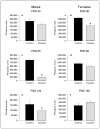Developmental effects of prenatal cocaine exposure on 5-HT1A receptors in male and female rat offspring
- PMID: 12697990
- PMCID: PMC3111017
- DOI: 10.1159/000069363
Developmental effects of prenatal cocaine exposure on 5-HT1A receptors in male and female rat offspring
Abstract
Prenatal cocaine exposure results in behavioral abnormalities throughout development in rats, but little is known regarding the biological mechanisms underlying these abnormalities. Pregnant rats received subcutaneous twice-daily injections (1 ml/kg) of normal saline or 15 mg/kg of cocaine hydrochloride throughout gestation (gestation days 1-20). Following delivery, pups were placed with untreated surrogates. Male and female pups were killed on postnatal days 30, 60 or 120 for assessment of 5-HT(1A) receptor development in the forebrain, diencephalon, midbrain and pons using radiolabel immunocytochemistry. Findings revealed gender and age differences in developmental regulation of 5-HT(1A) receptors, indicating that male rats are more susceptible to long-term consequences of prenatal cocaine exposure in comparison to females. This study also demonstrates gender-specific development of serotonin (5-HT(1A)) receptors across postnatal ages, demonstrating a fundamentally different pattern of development of 5-HT(1A) receptors between males and females.
Copyright 2002 S. Karger AG, Basel
Figures


Similar articles
-
5-HT(1A) and 5-HT(2A) serotonin receptor turnover in adult rat offspring prenatally exposed to cocaine.Brain Res. 2000 Sep 22;877(2):141-8. doi: 10.1016/s0006-8993(00)02668-8. Brain Res. 2000. PMID: 10986326
-
Potentiation of 5-HT1A receptor-mediated neuroendocrine responses in male but not female rat progeny after prenatal cocaine: evidence for gender differences.J Pharmacol Exp Ther. 1994 Dec;271(3):1453-61. J Pharmacol Exp Ther. 1994. PMID: 7996458
-
Paroxetine is effective in desensitizing 5-HT1A receptor function in adult offspring exposed prenatally to cocaine.Psychopharmacology (Berl). 2005 Jul;180(2):316-26. doi: 10.1007/s00213-005-2249-8. Epub 2005 Apr 28. Psychopharmacology (Berl). 2005. PMID: 15864558
-
Prenatal cocaine produces biochemical and functional changes in brain serotonin systems in rat progeny.NIDA Res Monogr. 1995;158:115-48. NIDA Res Monogr. 1995. PMID: 8594482 Review.
-
Neuropsychotoxicity of abused drugs: effects of serotonin receptor ligands on methamphetamine- and cocaine-induced behavioral sensitization in mice.J Pharmacol Sci. 2008 Jan;106(1):15-21. doi: 10.1254/jphs.fm0070121. Epub 2008 Jan 16. J Pharmacol Sci. 2008. PMID: 18198473 Review.
Cited by
-
Cocaine-induced neurodevelopmental deficits and underlying mechanisms.Birth Defects Res C Embryo Today. 2016 Jun;108(2):147-73. doi: 10.1002/bdrc.21132. Birth Defects Res C Embryo Today. 2016. PMID: 27345015 Free PMC article. Review.
-
Prenatal Cocaine Disrupts Serotonin Signaling-Dependent Behaviors: Implications for Sex Differences, Early Stress and Prenatal SSRI Exposure.Curr Neuropharmacol. 2011 Sep;9(3):478-511. doi: 10.2174/157015911796557957. Curr Neuropharmacol. 2011. PMID: 22379462 Free PMC article.
-
Gender considerations in ventilatory and metabolic development in rats: special emphasis on the critical period.Respir Physiol Neurobiol. 2013 Aug 15;188(2):200-7. doi: 10.1016/j.resp.2013.06.013. Epub 2013 Jun 21. Respir Physiol Neurobiol. 2013. PMID: 23797186 Free PMC article.
-
Exploiting human anatomical variability as a link between genome and cognome.Genes Brain Behav. 2006;5 Suppl 1(0 1):64-77. doi: 10.1111/j.1601-183X.2006.00196.x. Genes Brain Behav. 2006. PMID: 16417619 Free PMC article. Review.
-
Cocaine disrupts pup-induced maternal behavior in juvenile and adult rats.Neurotoxicol Teratol. 2007 Nov-Dec;29(6):634-41. doi: 10.1016/j.ntt.2007.07.003. Epub 2007 Jul 14. Neurotoxicol Teratol. 2007. PMID: 17698321 Free PMC article.
References
-
- Akbari HM, Kramer HK, Whitaker-Azmitia PM, Spear LP, Azmitia EC. Prenatal cocaine exposure disrupts the development of the serotonergic system. Brain Res. 1992;572:57–63. - PubMed
-
- Akbari HM, Whitaker-Azmitia PM, Azmitia EC. Prenatal cocaine decreases the trophic factor S-100β and induced microcephaly: Reversal by postnatal 5-HT1A receptor agonists. Neurosci Lett. 1994;170:141–144. - PubMed
-
- Bar-Peled O, Gross-Isseroff R, Ben-Hur H, Hoskins I, Groner Y, Biegon A. Fetal human brain exhibits a prenatal peak in the density of serotonin 5-HT1A receptors. Neurosci Lett. 1991;127:173–176. - PubMed
-
- Battaglia G, Cabrera TM. Potentiation of 5- HT1A receptor-mediated neuroendocrine responses in male but not female rat progeny after prenatal cocaine: Evidence for gender differences. J Pharmacol Exp Ther. 1994;271:1453–1461. - PubMed
-
- Battaglia G, Cabrera TM, Van De Kar LD. Prenatal cocaine exposure potentiates 5-HT(2a) receptor function in male and female rat offspring. Synapse. 2000;35:163–172. - PubMed
Publication types
MeSH terms
Substances
Grants and funding
LinkOut - more resources
Full Text Sources

